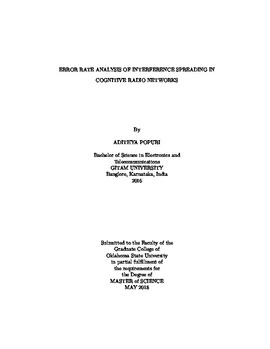| dc.contributor.advisor | Ekin, Sabit | |
| dc.contributor.author | Popuri, Adithya | |
| dc.date.accessioned | 2019-03-29T15:39:59Z | |
| dc.date.available | 2019-03-29T15:39:59Z | |
| dc.date.issued | 2018-05-01 | |
| dc.identifier.uri | https://hdl.handle.net/11244/317820 | |
| dc.description.abstract | As wireless technology continues making giant leaps on a daily basis, the current legacy spectrum allocation system will not hold good for long. Upcoming technologies like Artificial Intelligence and Internet of Things demand massive bandwidths and super-high data rates. There is a looming spectrum shortage crisis which could lead to the demise of wireless communications. Cognitive Radio (CR) with its smart and efficient use of radio spectrum is proposed as a solution to this crisis. It exploits the spectrum holes generated by the legacy allocation system, to transmit information of unlicensed users. The main function of a CR system, is to share the available spectrum efficiently between a primary user (PU) and a secondary user (SU). PU's are given better quality of service (QoS) while SU's can use the spectrum with co-operation from the PU. Spectrum sensing is the core of a CR system as it senses whether the spectrum is occupied by a PU. If not in use, the CR system permits a PU to transmit information through the same frequency band. In this way, a CR can efficiently share spectrum, which unclogs the available spectrum. However, the main issue with spectrum sensing is its unreliability in dynamic environments. It is also extremely power hungry since it has to monitor the spectrum at all times for idle bands. This makes spectrum sensing impractical for power-limited systems. Thus, in our work, we use a method called interference spreading to distribute interference, along with interference temperature. Interference spreading is a viable alternative to the power-hungry spectrum sensing. In our work, absence of spectrum sensing is assumed, which would lead to collisions between PU's and SU's. Orthogonal Frequency Division Multiplexing (OFDM) method is assumed, where sub-carriers are assumed to be allocated randomly. We then use Bit Error rate (BER) as a metric to determine the performance of the system. The SU's power is varied while PU's power is kept constant, along with a fixed value for interference temperature. BER of a SU is calculated for various modulation schemes. The main contribution of this thesis is the performance analysis of a CR system with the use of interference spreading method. | |
| dc.format | application/pdf | |
| dc.language | en_US | |
| dc.rights | Copyright is held by the author who has granted the Oklahoma State University Library the non-exclusive right to share this material in its institutional repository. Contact Digital Library Services at lib-dls@okstate.edu or 405-744-9161 for the permission policy on the use, reproduction or distribution of this material. | |
| dc.title | Error Rate Analysis of Interference Spreading in Cognitive Radio Networks | |
| dc.contributor.committeeMember | Stine, James Edward | |
| dc.contributor.committeeMember | Latino, Carl | |
| osu.filename | Popuri_okstate_0664M_15751.pdf | |
| osu.accesstype | Open Access | |
| dc.description.department | Electrical Engineering | |
| dc.type.genre | Thesis | |
| dc.type.material | text | |
